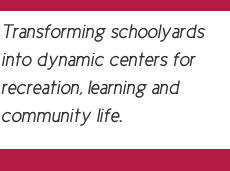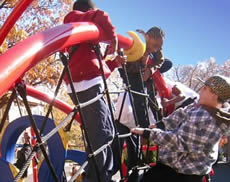History
In 1994, the Boston GreenSpace Alliance and the Urban Land Use Task Force approached Mayor Thomas M. Menino to initiate a dialogue about the state of Boston’s public schoolyards and the possibility of public and private sectors cooperating to revitalize these historically neglected spaces. Although ad hoc groups around the city were working to improve their local school grounds, projects were taking 5-8 years to complete and all suffered from a lack of capital investment. The Mayor enthusiastically convened a broad-based Schoolyard Task Force to devise a process which would fund projects and help hasten their completion. The Boston Schoolyard Initiative (BSI) public/private partnership was formally launched in 1995 and has been active ever since.
The Task Force’s recommendations went beyond the creation of the Initiative itself and emphasized the importance of making all the schoolyard projects local and participatory. To encourage this, they suggested establishing a competitive grant-making program that would reward projects which were inclusive of all potential stakeholders. They established the following goals, which still hold today:
- Touch every neighborhood in the City and every Boston Public Schools student
- Create attractive public spaces for recreation, education and civic activity
- Support meaningful and innovative educational use of schoolyards
- Cultivate significant public participation, including many community-based organizations, in both the design and stewardship of the schoolyards.
Between 1995 and 2013, BSI completed projects on 88 schoolyards. The BSI schoolyard model always had active play as a major goal; in recent years it evolved to include urban outdoor classrooms, specifically designed for teaching and learning. Our program grew to include professional development support for Boston Public School teachers. Our Science in the Schoolyard Program partnered with a national science curriculum developer, the Full Option Science System (FOSS), to create guides for taking the FOSS curriculum outdoors, and our Outdoor Writers Workshop worked to improve writing instruction using the schoolyard. We reached 850 teachers at more than 50 schools, enriching teaching and learning, and introducing children who have limited access to the outdoors an opportunity to experience nature just outside their school door.
In December 2013, the Boston Schoolyard Funders Collaborative closed its doors, and the City and BPS are planning to build on the foundation laid through our pioneering partnership.




